
The purpose of this study was to evaluate the physical performance and develop the criteria of 4243 middle and high school students across 5 provinces (Busan, Gwangju, Daejeon, Gyeongi and Jeonbuk) in Korea that took part in the talent development project. The data was collected between 2011 and 2014. The criteria was divided by gender and age across different grades, and the mean, standard deviation and 5 evaluation levels were calculated and analyzed.



The purpose of this study was to investigate the level of factors associated with points and the difference among weight categories after the revision of wrestling competition rules from video images. Factors associated with points were average point per a game, average points according to playing type, the occurring frequency of point according to the skills, the frequency and successful ratio of Parter, and the time zone of points occurred. The video contents were concerned on athletes ranked in 1 - 5 (6 person) at 59, 66, 75 Kg categories of Greco-Roman style in the 2014, 2015 World Wrestling Championship. The analysis was done by watching TV monitor several times. Five quantitative factors were tested between weight categories. As the results, no significant difference was found in average obtained point, but significant difference was found in average lost point (p<.05). Average obtained point showed significant difference in cross effect of the type of game and weight category. And average lost point showed significant difference in the type of game (p<.01) and weight category (p<.05), too. The frequency of point by skills of stand and ground wrestling showed significant difference in weight category (p<.001). However, no significant difference was found in frequency of point by time zone among weight categories. In conclusion, the point obtained and lost and the frequency of it are associated with the type of game and skills included in it of Greco-Roman style wrestling. New training program focused on enforcing the correct type of game and skills in it might be useful for developing the performance.
The purpose of this study was to analysis of moving distance during games, time and heart rate for hockey games using GPS (global positioning systems) by positions in Korea national female athletes. The subjects were Korea national female hockey players (n=13) including 4 forwards, 4 midfields, and 5 fullbacks that participated in five Korea vs. Japan international games. All subjects were wearing GPS throughout the games. The results were as follows: Firstly, the average total travel distance per game was approximately 5.7km and higher in the second half. Physical movement in the games was not different from positions where 70% of physical movement was performed at low intensity and 30% at moderate and/or vigorous intensity, suggesting that the subjects; physical movement was performed at the appropriate level of exercise intensity. Secondly, during the game, the subjects performed physical movement faster than 11km/h for 22 minutes, indicating that the subjects could maintain their physical movement at a relatively faster speed throughout the games. In particular, midfields showed a greater amount of physical movement at moderate speed. Thirdly, the average exercise heart rate was 145bpm, which was equivalent to 60% of HRmax. The subjects maintained their average exercise heart rate greater than 150bpm (above 60% of HRmax) for 40 minutes during the games, indicating that the players had an ability to maintain physical movement at high intensity throughout the games. In conclusion, in spite of the fact that Korea national female hockey players have an ability to maintain physical movement at a relatively faster speed and higher intensity, their physical movement and performance are often affected. Therefore, it is necessary to develop and apply the specific interval training program for national female hockey players that can facilitate the faster recovery from the repetitive physical movement requiring power and speed at high intensity.
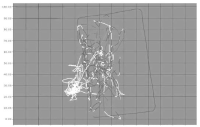
The purpose of this study was performance improvement through analysis of movement in elite field hockey players regarding positions using real-time GPS monitoring for compared training game and 2014 Incheon Asian Games. Fifteen elite women field hockey players (Defender: 4, Mid-fielder: 6, and Forward: 5) participated in this study. There were 2014 Incheon Asian Games Korean national team. Real-time GPS system analysis was completed during 10 training game appearances 5 2014 Incheon Asian Games appearances. The results of this study showed that in training game mid-fielder>forward>defender for 3, 4, 5, and 6 zone at speed zone by moving distance, in 2014 Incheon Asian Games forward>mid-fielder>defender for 6 zone at speed zone by moving distance. And moving distance by quarter increased all position in 2014 Incheon Asian Game more than training game. Therefore, These data might be useful to analysis of movement in field hockey players. Moreover improved performance and individual exercise ability by feedback for players distance, heart rate, and exercise trajectory. Thus, Gold-medal won at the 2014 Incheon Asian Games in field hockey.

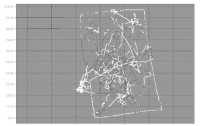

This study aimed to examine the change of the indices in blood gas, ions, and by-products of fatigue substances and components in collegiate elite Kumdo competitors, who carry out a number of competitive games during one day tournament event. Subjects were carried out total 6 simulated, but followed same conditions and rules of actual competition, with providing similar inter-game break time. Eight well trained male competitors, who had awarded from national wide competitions, voluntarily participated in this study and revealed 51.5(±8.8) mL·kg-1min-1 of maximal oxygen consumption and 12.4(±5.1) % body fat. TWOWAY ANOVA (tournament round vs. pre & post each game) was adopted to test whether the mean differences were existed, and the interaction between individual factors and main effect within each factors were analyzed. Statistical significance was set at Alpha (α) = .05. While there were no significant changes in blood hydrogen ion concentration (i.e., pH) and partial pressure of oxygen (PO2), partial pressure of carbon dioxide (PCO2) significantly decreased as the tournament games were repeated. The level of hemoglobin and hematocrit were significantly elevated only during the 1st round of tournament. Na+ was significantly increased but K+ was decreased. Ca2+ concentration however, was not significantly altered. Although the changes of blood glucose level did not show any consistent patterns, free fatty acid (FFA) concentration was increased after completed each game compared to prior to initiate the each game. Blood NH3, lactic acid, and uric acid concentration increased at immediately after each game, and the pattern was maintained throughout the tournament round continued. These results reflected that the repeated participation of the tournament may cause the accumulation of the by-products of fatigue substances in blood and alteration of various ion components and energy substrates. Accordingly, the ways of reducing the physical fatigue and providing adequate energy source inter-tournament games needs to be necessarily considered for successful Kumdo competition. Data obtained from this study could valuable for searching the effective training and management methods to improve the performance and reduce the fatigue of the professional elite Kumdo competitors.

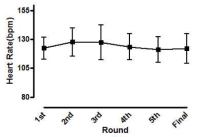
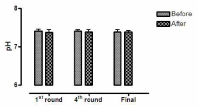
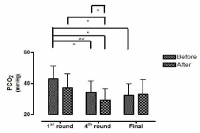
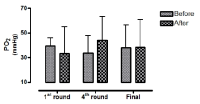
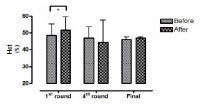
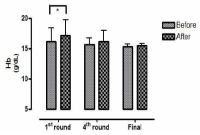
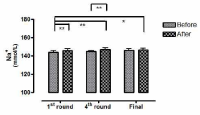
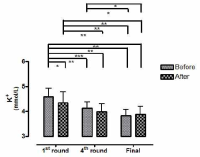


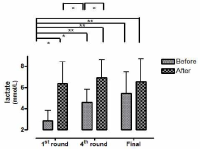
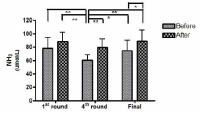
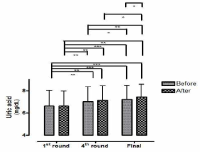
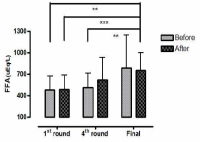
This study aims to suggest the guide line for weight category sports(Taekwondo, Judo, Wrestling, Weightlifting, and Boxing) who have to lose weight to pass weigh-in before games. Reference data was collected from RISS, Medline, PubMed, SciELO and effects of short term weight loss on physiological variables(body composition, physical fitness, blood components, oxidative stress and hormone, immune function) were analyzed. Also, weight loss procedures for weight category sports athletes were analyzed in details. The results of the research are as follows: weight category sports athletes prefer short term (3~5 days) weight loss methods (3~5%) with dietary control, sweating and exercise. Physical changes caused by the loss in body weight, fat-free mass, and BMI, however, do not affect body fat percentage. Different changes of physical strength element depend on weight reduction period. In short term weight loss method, anaerobic exercise capacity, muscular strength, and reaction time partially decrease and affect staying power. In contrast, long term weight loss method do not affect aerobic and anaerobic exercise capacity. Furthermore, most of previous studies show that blood component change has negative effect on body water balance, stress-related hormone, and immune function. In conclusion, short term weight loss method negatively affects athletic performance of weight class competition athletic. Therefore, careful long term weight loss methods are recommended with dietetic consideration to prevent dehydration during weight loss period. Excessive weight loss on lightweight athlete should be prevented by institutional basis as well.
PURPOSE This study aimed to identify ACTN3 gene polymorphisms amongprofessional ssireum players by weight class and between elite and non-elite players,and to select genotype that matches the characteristics of the sport. METHODS The subjects of this study were 148 male athletes currently working as professionalssireum players. Chi-square test cross-tabulation analysis was conducted to examinethe differences in ACTN3 genotypes between weight classes and between elite andnon-elite players. RESULTS There were no significant differences in allele or genotypebetween ssireum players, but there were significant differences in R-allele and XXgenotype. CONCLUSIONS Players with the R-allele type of the ACTN3 gene weremore often classified as elite. Using this marker as a basis for organizing a playerselection and training programs would be more effective in training those that matchthe characteristics of elite players of the game.
PURPOSE The purpose of this study is to examine the goalkeeper’s area of defense and how the range varies depending on the relative position of the goal, goalkeeper, and ball in a 9-meter jump shot during handball matches. METHODS Data was collected from seven qualifying divisions in mens handball from the 99th National Sports Festival in Korea. A total of 231, 9-meter jump shots were analyzed with the goalkeeper‘s area of defense measured from the point the ball left the shooter’s hand and calculated based on the relative position of the goal, goalkeeper, and ball. Video analysis was conducted using the Kwon3D 3.01 program and three-dimensional coordinates calculated using the DLT method. RESULTS First, dimension of handball goals measure 3m wide and 2m high, however, results show that goalkeeper’s actual area of defense was narrower than the width of the goal posts, while vertically, area exceeded the height of the cross bar. Second, if the goalkeeper defended the striker’s shot from the side rather than from the front, the goalkeeper’s defense range was higher for the opposite side of the goal post than the near side of the goal post. CONCLUSIONS Key factors influencing goalkeeper’s area of defense include height of shot and position of goalkeeper. Results also indicate that vertical movements are more important than horizontal movements for goalkeepers in handball thus such implementation in training may lead to performance enhancement.
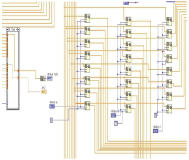
This study was to develop and to apply real-time neurofeedback system for psychological self-regulation of shooters. Neurofeedback system was developed with expert meetings consisting of 8 sport psychology, EEG, and sport engineering experts based on Labview program. Developed neurofeedback system was applied to 4 college shooters for 10 sessions(1 session/week, 30 mins/session). Collected EEG wave data were analyzed by paired sample t-test and independent sample t-test. The results were as follows: Firstly, based on user experience concept neurofeedback system was developed which easily perceived neurofeedback information as traffic lights with minimizing visual search activities. Secondly, after neurofeedback system application right brain activation level of shooters(except one shooter) were increased compared to left brain activation. Based on the results of this study, neurofeedback system can apply various sports and contribute to help athletes’ self-regulation and athletic performance enhancement in sport field.


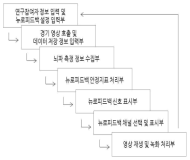


Purpose The purpose of this study was (1) to develop and to apply the PE classes based on Sportscasting Model on Creativity and Character and (2) to analyze the effects of PE classes on Creativity and Character. Methods Participants were 10th high school students(N=172) who had not experienced PE classes on Sportsasting Model. Data were collected using An Integrated Creativity Test(Lee & Lew, 2012), open-ended questionnaires and in-depth interviews with students. The data were analyzed through paired samples t-test and qualitative content analysis. Results Results showed that (1) Table-tennis and volleyball lessons on Sportscasting Model were developed and applied, and (2) significant differences were observed in creative thinking and creative personality of students’ creativity scores after lessons. And 14 creativity factors and 10 character factors were drawn from the analysis of questionnaires and interviews. Conclusion And to conclude, Sportcasting Model is efficient in developing creativity and character. Discussions were provided in terms of the development and application of PE classes based on Sportsasting Model and the effectiveness of Sportscasting Model.


